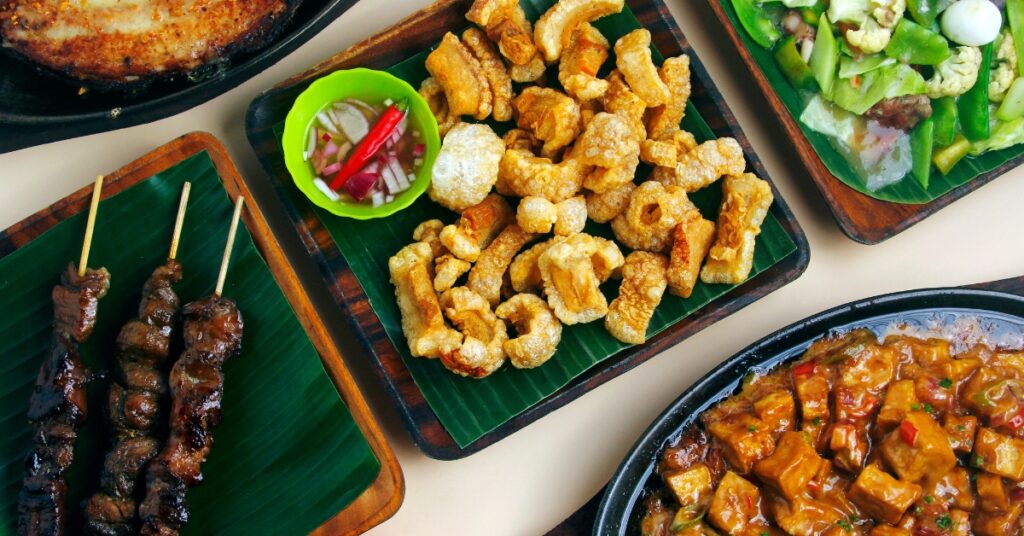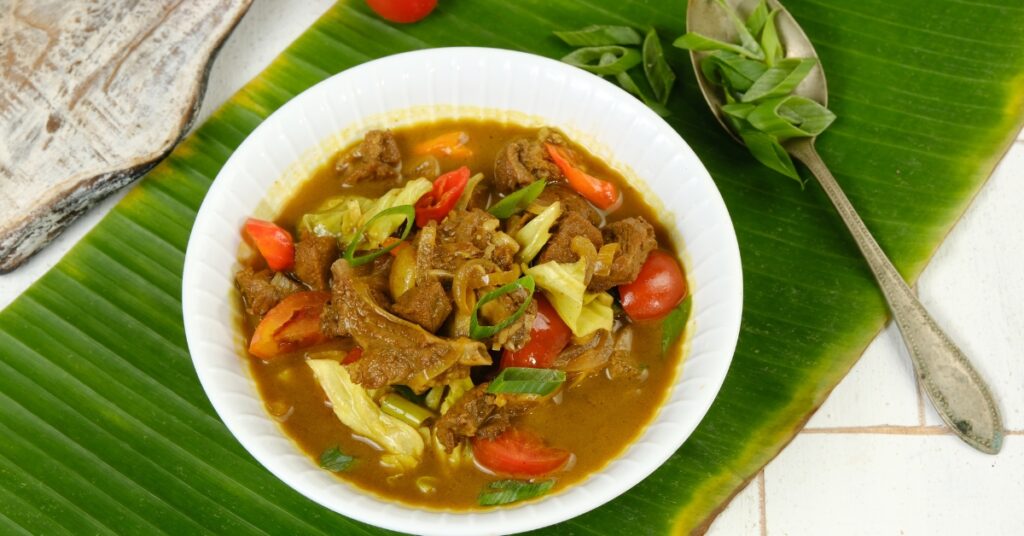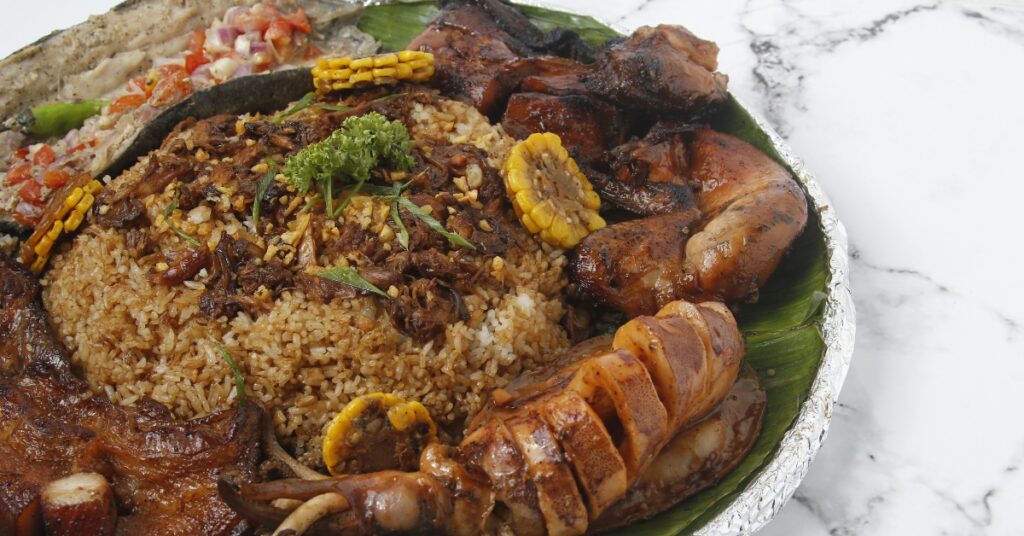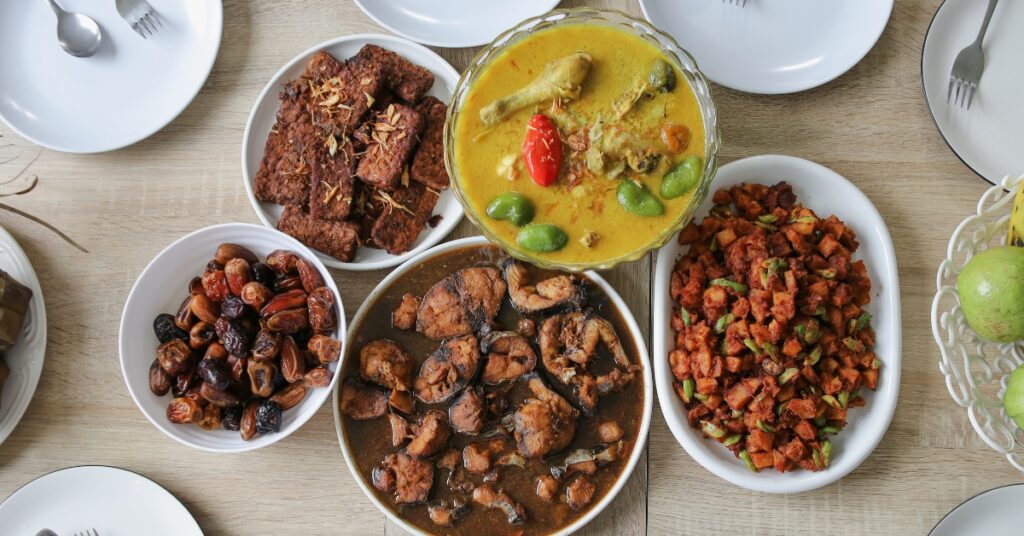Adobo: The Quintessential Filipino Dish

A staple in Filipino homes and fiestas, adobo is a tasty meat meal that features tender meat cooked in soy sauce, vinegar, garlic, and other aromatics. “adobo” comes from the Spanish word “adobo,” which means to marinate or marinade. This dish, with its roots in Spanish cuisine, reflects the influences of Spanish colonization in the Easy Filipino Food Recipes and has become a renowned representation of Filipino cuisine, showcasing the country’s rich history and cultural diversity.
To make adobo, marinate your protein option (pork, chicken, and even tofu) with soy sauce, vinegar, garlic, peppercorns, and bay leaves for at least 30 minutes. Cook it with the marinade till tender, and the sauce becomes thick and
Adobo is one of the most popular Filipino meals, an appetizing and savory stew ideal for any day of the week. Originating from Spanish food, this dish has been adapted by Filipinos to consist of regional active ingredients and flavors.
- Here’s an easy dish for chicken adobo that you can quickly make at home:
- Active ingredients:
- 1kg chicken pieces (thighs or legs).
- 1/3 cup soy sauce.
- 1/3 cup vinegar.
- 2 cloves garlic, minced.
- 1 bay leaf.
- Salt and pepper to taste.
- Directions:
- In a large pot, combine chicken and soy sauce.
- Adobo, often called the national dish of the Philippines, is a versatile meal that can be adapted to fit individual preferences. Adobo can be customized to your liking, whether you prefer a more pungent taste with extra garlic, a creamier texture with coconut milk, or added nutrition with vegetables. It’s best served with steamed rice, which helps balance the savory flavors of the dish.
Sinigang: A Comforting Soup for Rainy Days.
Singing is a popular Easy Filipino Food Recipes known for its sour and savory taste. When you’re yearning for something comforting and warm, this hearty meal is perfect for rainy days.
Singing can be made with various types of protein, such as pork, beef, chicken, fish, or shrimp. The primary active ingredient that gives singing its distinct sour taste is tamarind, which can be fresh fruits, paste, or powder.
Sinigang can also be prepared with a twist besides the timeless sour and savory flavor. Likewise, blend versions integrate active ingredients from other foods, such as miso paste for a Japanese touch or peanut butter for a Filipino-style Kare-Kare sinigang.
Sinigang is a popular dish in the Philippines and has gained acknowledgment. It has been recognized in different food programs and is noted as one of the must-try Filipino dishes by travel publications. Its savory and sour flavors have recorded the taste buds of people from various cultures, making it a genuinely flexible meal that anyone can enjoy.
Aside from its delicious taste, singing also offers a range of health benefits. The use of different vegetables in the dish provides essential vitamins and minerals. At the same time, the tamarind base is known for its antioxidant properties, helping boost the immune system and fight diseases. So, not only is singing a delightful meal, but it’s also a nutritious addition to your diet. By choosing sinigang, you’re enjoying a delicious meal and making a healthy choice for your body.
In conclusion, sinigang is more than simply a popular Easy Filipino Food Recipes. Its versatility, unique taste profile, and health advantages make it a meal worth trying for foreigners and residents.
To make sinigang, the protein and vegetables are first sautéed in a pot with onions, garlic, and tomatoes. Some variations of sinigang include adding coconut milk for a creamier broth or using various types of meats like beef ribs rather than pork.
Aside from its tasty taste, sinigang is also a nutritious meal. Using fresh veggies provides essential vitamins and minerals, while the protein from the meat includes protein in one’s diet plan. Adding tamarind gives sinigang its signature sour taste and adds vitamin C to the dish.
Sinigang is likewise a flexible dish that can be personalized according to one’s choices. For those who choose a more tasty flavor, more tamarind can be added, and for those who like it less sour, less tamarind can be utilized. Vegetarians can also enjoy this dish by using tofu as a substitute for meat.
In Filipino food, sinigang holds an important location. It is typically served throughout unique celebrations or as a comfort food for numerous Filipinos. It is likewise a popular guest meal, showcasing Filipino culture’s hospitality and warmth.
Apart from tamarind, other souring representatives can be utilized in sinigang, such as guava, calamansi, and kamias. Each component adds a distinct taste profile to the dish, making it much more fascinating to attempt different variations.
Sinigang is not just restricted to pork or beef; seafood like shrimp and fish can also be utilized to make this tasty meal. Some regions in the Philippines have their version of sinigang, using ingredients like labanos (radish) or fruit in your area.
To make sinigang, the meat is boiled in water with onions and tomatoes until tender. As soon as prepared, the main component (pork, beef, seafood, or veggies) is included along with tamarind paste or fresh tamarind fruit to provide the meal its signature sour taste.
Other active ingredients include string beans, okra, kangkong, and eggplant (water spinach). These vegetables add only use and color to the dish and offer nutrients.
In some sinigang versions, extra tastes, such as fish sauce (patis) or soy sauce (Toyo), are integrated for a hint of saltiness. Some also like to add chili peppers for a spicy kick.
Sinig.
Sinigang is another popular Filipino dish known for its sourness.
Adobo is the unofficial national meal of the Philippines, and it is for good reason. This timeless meal features tender meat prepared in a delicious sauce made from vinegar, soy sauce, garlic, and peppercorns.
Another cherished dish in the Philippines is sinigang. Comparable to adobo, it likewise has a savory and tasty taste. What sets sinigang apart is its usage of souring agents like tamarind, guava, or kamias. These active ingredients offer the soup-based dish its distinct tartness that pairs completely with the tender meat and vegetables. Sinigang can be made with meats such as pork, fish, shrimp, or beef. It’s a hearty and reassuring meal that Filipinos like.
Components:
- 1 kg chicken or pork (cut into bite-size pieces).
- 1/2 cup vinegar.
- 1/2 cup soy sauce.
- 4 cloves garlic (minced).
- 1 tsp entire black peppercorns.
- Bay leaves (optional).
Guidelines:
- In a large pot or deep pan, combine.
- If there’s one dish that specifies Filipino cuisine, it needs to be adobo. Known for its rich, appetizing, and mouthwatering taste, this dish simmers your choice of meat (commonly chicken or pork) in a vinegar-and-soy-based sauce.
- Simple Chicken Adobo Recipe.
Active ingredients:
1 kg chicken (cut into bite-size pieces).
1/2 cup vinegar.
1/2 cup soy sauce.
4 cloves garlic (minced).
1 tsp whole black peppercorns.
- Optional:
- Bay leaves.
Instructions:
Integrate the chicken, vinegar, soy sauce, minced garlic, and black peppercorns in a big pot or deep pan.
Include them in the mixture if bay leaves are used.
Let it marinate for at least an hour in the fridge.
Bring the mixture to a boil over medium-high heat as soon as marinated, then lower the heat.
Active ingredients:
1 1/2 pounds chicken thighs or drumsticks.
1/2 cup soy sauce.
1/4 cup white vinegar.
3 cloves garlic, minced.
2-3 dried bay leaves.
1 tsp black peppercorns.
1 cup water.
1 tbsp cooking oil.
Instructions:
Marinate the chicken in soy sauce, garlic, and black peppercorns for at least 30 minutes.
Heat oil in a pan and brown the chicken pieces.
Add the marinade, vinegar, bay leaves, and water to the pan.
Simmer for 25-30 minutes or until the chicken is tender and the sauce is minimized.
Serve hot with steamed rice.
Cooking Tip:
For a more flavorful adobo, utilize chicken thighs instead of breast meat.
Add other components, such as potatoes or hard-boiled eggs, to make it a one-pot meal.
If you are seeing your salt consumption, use low-sodium soy sauce.
Adobo is an essential dish in Filipino food and has become popular worldwide for its distinct flavor and versatility. It is a simple yet tasty meal that can be made with various kinds of meat, such as pork, beef, or even seafood. Adobo is also known for being an excellent alternative for meal prepping as the flavors develop much more when left overnight.
Aside from its taste.
If you desire a more tasty adobo, add spices, such as dried chili peppers, cinnamon sticks, and star anise. You can also try various vinegar types, like apple cider or coconut. Adobo is versatile and can be made with proteins like pork, beef, or veggies for vegetarian options. It’s a meal with limitless variations and can be adapted to suit individual choices.
History of Adobo.
Adobo is considered the Philippines’ national meal. It has been an integral part of Filipino food for centuries. “adobo” comes from the Spanish term “adobo,” which suggests marinating or seasoning meat.
The.
Adjust the vinegar-to-soy-sauce ratio based on your taste. Some choose more tang, while others like it saltier.
Sinigang: The Sour and Savory Soup.
Sinigang is a traditional Filipino soup known for its signature sour broth. The dish usually features tamarind and meat, seafood, or veggies as the taste base.
Quick Pork Sinigang (Serves 4).
Components:
- 1 pound pork belly or pork ribs, cut into pieces.
- 8 cups water.
- 2 medium tomatoes, quartered.
- 1 medium onion, sliced.
- 1 pack tamarind soup mix (easily found in Asian markets).
- One cup sitaw (string beans), cut into 2-inch pieces.
- 1 cup kangkong (water spinach) or spinach leaves.
- 1 cup radish pieces.
- 1-2 green chilies.
Guidelines:
- Boil pork in water with onions and tomatoes till the meat hurts (about 45 minutes).
- Include the tamarind soup mix and stir well.
- Toss in the radish and sitaw, cooking until vegetables hurt.
- Include kangkong and green chilies. Simmer for another 2 minutes, then serve.
Cooking Tip.
Sinigang is flexible! Alternative tamarind with calamansi, tomatoes, or green mangoes for a distinct twist.
Pancit: Stir-fried noodles for Any Occasion.
Whether celebrating a birthday or just yearning for something hearty, pancake (Filipino noodles) is always a hit. There are numerous versions, but pancit bihon is among the easiest and most popular.
Easy Pancit Bihon Recipe.
Active ingredients:
- 8 oz rice noodles (bichon).
- 2 tablespoons cooking oil.
- 2 cloves garlic, minced.
- 1 medium onion, sliced.
- 1 cup combined veggies (carrots, cabbage, celery).
- 1 cup cooked chicken, shredded.
- 2 tbsp soy sauce.
- 1 tablespoon oyster sauce.
- 1 1/2 cups chicken broth.
Instructions:
- Soak the rice noodles in water for 10 minutes, then drain.
- Heat oil in a pan and sauté garlic and onion.
- Include chicken and vegetables, cooking up until softened.
- Stir in soy sauce, oyster sauce, and chicken broth.
- Toss in drenched noodles, mixing till completely covered and cooked through. Serve warm.

Cooking Tip.
You can tailor pancit by adding tofu, pork, or shrimp.
Lumpiang Shanghai: Crispy and Delicious Spring Rolls.
Lumpiang Shanghai (Filipino spring rolls) are crowd-pleasers. Crispy on the outside and breaking with savory fillings on the inside, this appetizer is easy to prepare and best for sharing.
Lumpiang Shanghai Recipe.
Components:
- 1 lb ground pork.
- 1/2 cup minced carrots.
- 1/2 cup minced onions.
- 1 egg.
- 2 tablespoons soy sauce.
- 1 tsp ground black pepper.
- Spring roll wrappers.
- Cooking oil for frying.
Directions:
- Mix pork, carrots, onions, egg, soy sauce, and pepper in a bowl.
- Lay a spring roll wrapper on a flat surface area and place a spoonful of the pork mix on one side. Roll tightly and seal the edge with water.
- Deep-fry rolls in hot oil up until golden brown.
- Serve with sweet chili sauce for dipping.
Cooking Tip.
Freeze any raw rolls for future use. When required, pop them straight into the fryer!
Easy Dessert Option: Turon (Banana Spring Rolls).
Turon is a sweet Filipino treat that’s best for beginners. These crispy banana spring rolls, often filled with jackfruit for included taste, make a fantastic dessert or treat.
Turon Recipe.
Active ingredients:
6 ripe saba bananas or plantains, sliced up lengthwise.
3 tablespoons brown sugar.
6 spring roll wrappers.
Cooking oil for frying.
Directions:
Roll banana slices in brown sugar till equally layered.
Location the banana on a spring roll wrapper, fold the sides, and roll firmly. Seal the edge with water.
Heat oil in a pan and fry the turon till golden and crispy.
Drain pipes with excess oil on paper towels and serve warm.
Cooking Tip.
For additional extravagance, drizzle your turon with caramel or serve it with a scoop of vanilla ice cream.
Tips for Sourcing Ingredients.
Filipino food typically calls for specialty active ingredients, but don’t fret! Here’s where you
can find them:
Visit your local Asian supermarket for tamarind paste, bihon noodles, or saba bananas.
Certain frozen or canned items (like jackfruit and kangkong) can be discovered in the worldwide aisle of major supermarkets.
Order online! Many specialized Filipino items are readily available from e-commerce, so look for easy shipment to your doorstep.

Discover the Flavors of Easy Filipino Food Recipes.
Filipino food is a melting pot of conventional Malay, Chinese, Spanish, and American impacts. With its range of tastes and active ingredients, it uses a tasty and exceptional experience passed down through generations. From hearty stews to tropical desserts, Filipino food will surely please your yearnings and leave you wanting more.
Regional Cuisine.
The Philippines is divided into three significant areas: Luzon, Visayas, and Mindanao. Each region boasts distinct cooking customs and specialties based on regional fruits and vegetables and cultural influences.
In the northern island of Luzon, meals are greatly affected by Chinese cooking strategies. Popular meals include adobo (meat stewed in vinegar and soy sauce.
With these simple Filipino dishes, you’ll be whipping up authentic meals carrying your taste buds to the Philippines. Whether you’re enjoying the tangy punch of adobo, the soothing warmth of sinigang, or the sweet crunch of turon, Filipino cooking is everything about creating remarkable meals for sharing.
If you’re ready to explore more dishes and open new tastes, why not try dishes todaipino food awaits?






